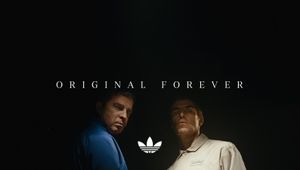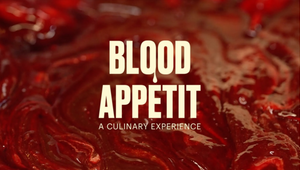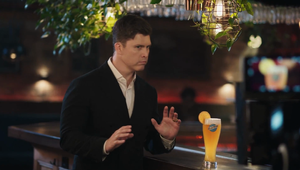
The VFX Factor: Yebin Ahn on 'Invisible Post'

Yebin Ahn was born and raised in South Korea. She went to the School of Visual Arts in New York City, and received her bachelor's degree in Computer Art, Computer Animation and Visual Effects. She joined Blacksmith as a compositor shortly after graduation. Since then she has been working on projects with clients such as Apple, Facebook, Macy’s, Zillow, etc. and also music videos for Justice, Skrillex and Justin Bieber to name a few.
One of many things she wanted to do was to be an illustrator. She was always fascinated by the fact that whenever people read or hear a story, they have slightly different visuals in their minds. She wanted to physically share the unique imagery she came up with in her mind with others. Further, instead of interpreting an existing concept, she wanted to create a whole world based on her thoughts and designs, filled with original history and people in order to tell a story.
Watching the movie Inception was a major influence for her to pursue a path in visual effects. She started to pay attention to a whole other toolset that she could learn and use to bring her vision to life.
LBB> There are two ends to the VFX spectrum - the invisible post and the big, glossy 'VFX heavy' shots. What are the challenges that come with each of those?
Yebin> The root idea behind these two types of shots are fundamentally different. The ‘invisible post’ shots focus on problem solving, whereas glossy ‘VFX heavy’ shots are usually geared towards creating daunting images and impressing the audience. It’s not uncommon that both ideas intertwine.
The invisible VFX shots usually come from a limitation in filming. You might have to shoot a periodic project without enough set pieces so you’d need to extend/enhance the environment. You also have to consider the safety of actors when it comes to a dangerous action scene, which leads to more ‘invisible’ VFX work on our end. Or, you would shoot a shot with temporary screens but nobody knows what the footage insert is going to be like yet. Every situation is unique and challenging, but there will always be a solution for it. As a VFX artist it’s much easier for us to know what is going to be a problem ahead of the filming so we get enough time to plan for it. If that’s not the case, it’s always good to have a VFX supervisor on set for problems that might arise during the production. Some might think that the ‘invisible post’ shots are easier than big VFX heavy shots, but from a technical standpoint, there is minimal difference between the two. Even the ‘invisible post’ shots can require tons of CG assets and heavy compositing.
A giant, juicy VFX heavy shot doesn't really exist in reality. So you’d get more creative with designing a shot and art directing it. But the key is making it look good and closest to reality, which requires tons and tons of researching and gathering nice visual references. You also need to consider colors, lighting and compositions of the shot that would clearly present what this particular shot is trying to achieve in the project. It comes with hefty challenges and responsibilities, but I think the great reward of being part of making a glossy VFX heavy shot is that you can create an image that people have never seen before that awe them.
LBB> As a VFX person, what should directors be aware of to make sure you do the best possible job for them?
Yebin> Trust is important. We are all collaborating to make the best job possible. Each department is proficient at what they do. We, as VFX artists, believe in the director’s vision and storytelling. We believe that the DP will bring us magnificent images. And we, the VFX artists, are masters at VFX! If a director gives the VFX team full faith on what they are doing, it builds up another layer of confidence. It excites us. We understand what work needs to be done, but that added confidence gives us more creative freedom to explore, which, in turn leads towards a more stellar result.
LBB> VFX is a true craft in the classic sense of the word. Where did you learn your craft?
Yebin> I went to the School of Visual Arts and earned a BFA degree in Computer Art, Computer Animation and Visual Effects. Learning VFX software from teachers who are actively working in the industry definitely helped a lot in building/honing my skills and getting comfortable with the tools. I’m still constantly learning so much through my coworkers and troubleshooting complex shots.
Besides the technical aspect, I believe the craft of VFX also comes from a solid understanding of painting and photography. I spent a lot of my teenage days studying drawings and paintings as I wanted to be an illustrator. I continued doing so throughout my college years as well, taking advantage of going to an art school. What I found interesting since I started working in the VFX industry was that I kept finding myself making so much use of the painting/photography knowledge in VFX. You always have to consider lighting, colors, and compositions. The way you begin working on a big VFX shot is the same as how you would approach paintings. Getting the broad idea/strokes of the image right first and building details on top of it. Thinking about where to draw the focus of the image and where to leave it be. A nice VFX shot should never lack artistic taste.
I am grateful that I have learning in both areas, and they’re both something I’ll constantly work on.
LBB> Think about the very, very start of a project. What is your process for that? Do you have a similar starting point for all projects?
Yebin> It depends! The very beginning of a project usually involves gathering relevant references and making concept frames. You read a director’s treatment, understand the vision they have in their mind, and design visual concepts based on the references. If you are in a more creative position, you’ll pitch and discuss some of your ideas for the project. Good researching skills, along with the interest in already existing/trending media, helps a lot with this process.
For some projects, it is more about the execution. You analyse the whole project and what VFX needs to be done on each shot before beginning any actual work. You start out testing some shots with technical complexity, and see what actually works and what doesn’t. You make a plan for it, and just work away!
There are a few rare occasions that certain projects might need to be done in a day or two. In such cases, the starting process is simply dividing your time efficiently to finish whatever work needs to be done in a timely manner.
LBB> We imagine that one of the trickiest things with VFX is, time issues aside, deciding when a project is finished! How do you navigate that?
Yebin> Leonardo da Vinci’s famous quote might fit here: art is never finished, only abandoned. For me, it’s mostly about finding a fine line before it becomes too much. Anyone can keep working on a project forever, but knowing when to stop is important, or else it could ruin the whole picture. I usually make a series of big milestones to hit when I start working on a project. When those initial goals are accomplished, there usually comes another list of things I want to add on, which is mostly about finer details. Whatever comes to mind after that is a gamble for me, and that is usually where my stopping point is. It eventually comes to a point where doing something adds nothing to the project. It almost distracts, or misleads the whole imagery. That’s when I stop and call it finished.
Most VFX jobs work around deadlines and I don’t often come to think about this without the time constraints involved! This is an interesting topic and I’d be curious what other VFX artists’ think about this.
LBB> Is there a piece of technology or software that's particularly exciting to you in VFX? Why?
Yebin> Blacksmith recently bought the latest iPads to be a part of shoot kits. I was amazed and excited by the easy accessibility of LiDAR technology. Previously, you would’ve needed a few heavy cases of equipment to do it. But with Apple products’ latest technologies, you can get a good baseline environment scan from just your iPhone. Its accessibility and fast process will be such a powerful tool for on set VFX supervisors. They can test out VFX needs on the spot by putting 3D objects in the scanned scene, or even painting over an image. The ability to quickly determine what works or what doesn’t on set- instead of figuring it out after the shoot- will hopefully give us a more creative freedom rather than making most of the job troubleshooting problems that may arise. It even gets the measurements fairly correctly, and is able to export geometry and textures from the scanning. That bit is also very helpful for the CG department later.
LBB> Speaking of that, how have you navigated your role during Covid? Was there a big shift to remote? Tell us about your experience.
Yebin> Our industry already had the flexibility between working in the office or remotely. So I don’t think there was a big shift in that sense. Which doesn’t mean that everyone didn’t go through their hardships once the Covid’s first impacts hit. I just remember trying to put my best work as always, and be more attentive to communications as it was much harder to discuss everything through messages instead of live interactions. The whole Blacksmith team definitely powered through it though, picking up jobs we could do as it goes and gradually getting back to landing bigger and bigger VFX jobs even during the pandemic. Although it wasn’t an ideal situation for everyone, in the end I think Covid made remote work widely known/available and opened up a lot of opportunities to people, which, in my opinion, is one positive that came from it. We are now working with a lot more talented artists without any location restrictions.
LBB> Are there any lessons you've learned / experiences that you've had from working during Covid that you'll be looking to keep with you once things hopefully get back to some form of normality?
Yebin> Definitely keeping in mind the importance of clear and prompt communication. I took it for granted that I could just walk a few steps to anyone whenever I needed to talk about work, or anything, for that matter. I have experienced a situation where a slight delay or a minor misunderstanding led to slowing down the whole process. It was not fun. Even when things fully get back to ‘normal,’ we will always encounter some kind of hybrid working environment and it’s gonna be a good thing to keep in mind.
Another thing that I would like to continue doing is to keep finding new activities to do other than work. Work isalways going to be work. But with nothing else going on outside, I couldn’t just waste away all the extra time I had by mindlessly watching TV shows and playing computer games. So I bought a longboard for the first time last year. I started practicing guitar again, and when things slowly started to open up I began learning Archery. Another thing was deciding to get a driver’s license. I have so many more things to do on my list now! I feel like it’s a healthy thing and it’s also another motive for keeping a nice work-life balance.
LBB> How did you first get into the industry? What was your very first job in the industry and what were the biggest lessons that you learned at that time?
I applied to almost every VFX studio in NYC! Luckily, Blacksmith was one of the studios that got back to me. I loved the work that Blacksmith does, so naturally I decided to join their amazing team. My first project in the industry was Adidas Originals “Original is Never Finished” FW18 campaign. I cleaned up a lot of tracking markers and set imperfections, and did some beauty work on the talents. As a recent graduate I shortsightedly thought I had reached a close to final milestone in learning VFX. But the actual work experience only made me realize that there is still so much more to learn! And came to the realization that I probably will learn something new regularly even after I work over 10 or 20 years in the industry. Curiosity gets the best of me now. Whenever I see cool effects someone made or a really nicely composited image, I feel the need to ask the creator to learn what they did and how they did it. The cool thing is that I can pass on that knowledge to other people.
LBB> What was your first creative milestone in the industry – the project you worked on that you were super proud of?
Yebin> I had an amazing opportunity to work as a lead compositor on a music video for Skrillex’s song ‘Don’t Go’ featuring Justin Bieber and Don Toliver. It was such a fascinating experience to be able to just push for visuals that I thought would look the best, and seeing other people agreeing on it! Although there were references for the ideas and looks of the VFX sequence, there wasn’t really any real life footage to base the compositing on. It was a unique challenge for me to comp fully CG shots purely on its own. Our CG Lead, Tuna’s exceptional CG work and his take on the project made the whole process easier. I ended up quite enjoying the challenge after all, it was fun to play around with subtleties for different looks. Considering my first job mostly consisted of simple cleanups, I am super proud that I have grown so much working at Blacksmith to reach this point, and will continue to do so.
This is more behind the scenes take, but I also really enjoyed working on a few early concept frames for Zillow’s ‘The Journey’ before they went on a shoot. We had director’s sketches, references, location photos and basic CG assets. With those I got to comp and paint a few scenes of the spot with my creative input added. I think it was at this point that I really got drawn into its forest environment, which I ended up doing some parts of. Not every concept we did was used for the project. But it was really cool seeing the CG team pulling up some of the images I put together during the job.
LBB> From a VFX perspective, which ads have you seen recently that you've been particularly fond of and why?
Yebin> The ads themselves aren’t particularly new, but I recently came across Barclaycard’s ‘Water Slide’ and ‘NYC Roller Coaster’ commercials and really enjoyed watching them. They’re a classic VFX piece with a relatable, exciting idea! I do love making epic and dramatic images in ads as a VFX artist, but I think there’s also something more to it; to just have fun, and do work that touches people’s inner instinct to have fun.















